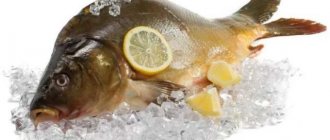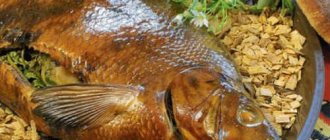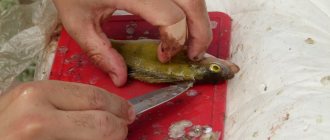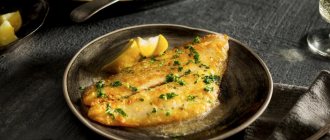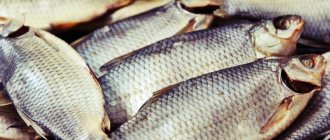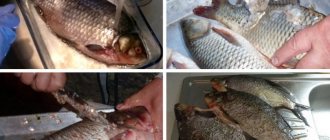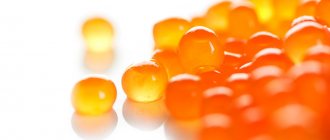If you are serving the fish whole, only the dark skin needs to be removed. The white skin will hold the fish whole during cooking. You can cook fish with or without the head.
- First remove the dark skin. Make a small cut near the tail to separate the skin from the flesh. Then slide the PSP directly under the skin until you have removed a large enough piece of pulp.
- Grasp the loosened edge of the skin with one hand and the tail with the other, using a cloth towel. Pull the skin firmly away from the tail and remove until it is separated from the head.
- Remove all black skin completely, then turn the fish over to the white side up. If you will also be removing white skin, run a sharp knife around the head to separate the skin.
- Insert your finger under the skin near the head and pull all the way to the tail, making sure that the skin is completely separated from the flesh. Grasp the skin at the tail end as described above and peel it off.
Filleting whole flat fish
Depending on the size, the flat fish can be made into two large double fillets or four single fillets. Before filleting, cut off the fins of the fish by going around the entire circumference of the fish where the meat meets the fins. The skin is usually left on the fillet to help it hold its shape.
Cooking single fillet
Using a sharp fillet knife, make a cut down the center of the fish from head to tail, reaching the spine.
Starting at the head end, insert the knife under the meat and drive down with long, firm strokes of the blade, keeping the knife horizontal as close to the rib bones as possible. Turn the fish over and repeat on the other side.
Double fillet
Go around the circumference of the fish to fillet it where the meat meets the fins, following the outline of the fillet. Carefully insert the knife on one side under the meat and slide it crosswise through the entire fish, going around the top of the spine when you reach it. Turn the fish over and repeat on the other side.
How to skin a flatfish fillet
After removing fillets from flat fish, it is better to remove the skin, especially dark skin; you can leave the white skin. This is not a difficult task, but it must be done correctly if you want the fillet to look neat and retain its shape. A sharp fillet knife is a must here.
Fillet knife
When filleting whole fish, it is preferable to use a special flexible fillet knife. Be extremely careful when handling such a knife - its blade is razor sharp. Dip your fingers in salt to make it easier to hold the fish skin in your hand.
How to remove skin from fillet
— Place the fillet, skin side down, on the board and, holding the PSP¶ at a slight angle to the surface, make a small cut near the tail end, reaching the skin without cutting through it.
- Pull the skin taut with one hand and slide the knife between the skin and meat at a slight angle. Keep the blade as close to the skin as possible and use a gentle sawing motion to slide the knife all the way under the meat.
Preparation of flounder fillet
After removing the skin, the flounder fillet can be fried in a frying pan in butter, first rolled in bread crumbs or dipped in batter, or poached. Flounder is ideal for deep-frying (goujon) or steaming (paupiette).
Goujons are thin, long strips of fish, cut diagonally or short, filleted crosswise, breaded in flour, egg and bread crumbs and deep-fried. They are usually served with tartar sauce.
Popiette
These are fish fillet rolls, usually flounder, with or without filling. They are steamed, baked or poached. If you chose stuffed rolls, place the filling on the fillet, roll with the skin inward and secure with a wooden skewer.
Based on materials from the book The Gourmet Bible (Le Cordon Bleu Kitchen Essentials)
How to remove the skin from a pike with a stocking?
The easiest way is to remove it with a stocking. To do this you will have to do some steps.
Cleaning the scales
The first thing to do is remove the scales from the fish carcass. This is not as easy to do as it seems, since the scales on the pike are held firmly, and the scales themselves are quite hard. It is better to do this operation outside, otherwise you can clog the entire kitchen. The easiest way to clean scales is with a sharp knife. Movements should be directed against the direction of scale growth.
Preparatory operations
After removing the scales, wash the fish, and then remove excess moisture with a paper towel. To make it convenient, you should select the entire desktop surface for this operation. A cutting board, a sharp knife and a container for waste will also come in handy.
Skin Removal Technology
This cutting stage is not only difficult, but also responsible. To begin, use a sharp knife to make several cuts near the gills. In this case, you should leave the space intact that connects the head and back of the fish. After this, the fish is gutted, removing all the insides, and washed thoroughly.
Before starting the process, you should pry the skin near the head with a knife. Some craftsmen cut off the fins right away, but this is not recommended, since after removing the skin there will be unsightly places that will need to be repaired.
To make the skin easier to remove, it is constantly pryed with a sharp knife. This is a very delicate and jewelry work that requires a certain amount of attention and concentration. In the places where the fins are located, they are trimmed with scissors, and the tail is cut off along with the skin removed.
How to quickly clean fish from scales: useful tips
The process of cleaning ordinary fish.
But there are some aspects and small tricks to make the process as pleasant and quick as possible:
- Fresh fish is best cleaned, not frozen or chilled. The living one has the most delicate and soft skin, from which the scales simply come out. It is best to clean fish immediately after fishing or purchasing.
- To prevent the scales from scattering, the fish can be cleaned in a transparent plastic bag, or in a container of water (or sink), into which the carcass is 100% immersed.
Or keep the fish under a running tap while cleaning. Wet scales do not fly far. - Frozen fish must be completely thawed before cleaning.
- If mucus remains after washing the carcass, then sprinkle it with salt and rinse again after 3 minutes.
- If the fish is going to be fried, then it is not necessary to clean a very small one. After heat treatment, the scales will become brittle and crispy.
- If the fish scales are compacted and large, then they can be removed by hand.
- It is easier to clean a carcass if you open its mouth and secure it with a toothpick.
- If the scales fit tightly to each other, they must first be divided with a knife without damaging the skin.
- Small scales are easily removed with sand or salt.
The fish is sprinkled and little rubbed. Later he washes himself in water. - If the fish slips out of your hands, you can secure it to the board with an awl. They pierce the carcass in the place above the tail. Or wrap the tail in a rag.
- If the scales are difficult to separate, then the fish is doused with boiling water or placed in it for one minute. Or put the carcass in hot water, and later in cool water and then continue cleaning.
- To easily clean frozen fish while it is melting, the carcass is wrapped in paper or cloth.
- You can clean the fish with the blunt side of a knife or use a fork.
- If the carcass is dry, it must be slightly moistened with water.
Cutting pike in the field
Most vacationers cook the caught fish directly near the reservoir. And this is understandable, since freshly caught fish is always much tastier, and even cooked in nature. Moreover, despite the fact that some devices are missing in nature, pike can be cut without any particular difficulties.
Cutting begins with removing the scales and entrails from the pike. These operations are carried out using a sharp knife, which is always available to vacationers or fishermen.
After this, the fish is thoroughly washed to remove excess odors, since marinating alone is unlikely to get rid of this. The fish can either be cut into pieces and fried in a frying pan, or cooked whole over coals, having previously coated the carcass with clay.
Many fishermen who go fishing for several days take with them all the necessary kitchen utensils, so there should not be any special problems with cooking fish outdoors.
Do I need to clean fish?
The most tedious and monotonous process after fishing is cleaning the fish. I want to quit this dirty business, and every now and then the question arises in my head: is it really necessary to clean fish? Our answer may surprise you, but no, this is not always necessary. For example, some types of fish are cooked directly in the scales: thus, it retains more useful microelements, which it is known to be very rich in. However, the question of how to cut fish is urgent, so this article is for us.
They clean it immediately before serving, and filter the broth or broth in which it was stewed through a sieve. An excellent way out of a situation when you don’t want small flakes scattered all over the kitchen. But this method is not always acceptable, and most fishermen still prefer to clean the fish first, and only then start cooking it.
Pike recipes
Pike has been valued for its nutritional value since ancient times, and dishes made from it were a real decoration for any celebration. Currently, many recipes for its preparation are known. It is not only fried, but also baked whole, and also stuffed with various cereals, which turns out tasty and nutritious.
Stuffed pike
Pike is prepared quite simply, but for this you need to stock up on additional ingredients. For example:
- Pike – 2 carcasses.
- One onion.
- One carrot.
- Loaf.
- One egg.
- Dill.
- Salt.
- Pepper.
- Olive oil.
Cooking technology:
- The fish is cleaned of scales and entrails. In this case, you should cut off the head and get rid of the gills, after which the fish is thoroughly washed. After this, the pike is skinned using a “stocking”, with the tail and fins removed.
- The stuffing filling is prepared from another pike fillet. To do this, take a loaf and cut off several fragments from it and soften it in warm water. The fish fillet is ground in a meat grinder with the addition of a soaked loaf.
- Then the onion is peeled and finely chopped. Take a carrot, peel it and rub it on a fine grater. Onions and carrots are lightly fried in olive oil, then salted and peppered.
- All ingredients are placed in a deep bowl and mixed, with the addition of eggs and chopped dill.
- Mix all this thoroughly and stuff the prepared carcass of another fish with it. The filling is not packed very tightly. The edges of the abdomen should be secured either with toothpicks or sewn up with simple (not artificial) thread.
- You can bake the head of the pike along with the body, but it must also be wrapped in foil.
- The baking dish is covered with paper, and a little oil is poured on top. The stuffed fish is placed on the paper and sprinkled with oil.
- The fish is cooked in the oven, preheated to 180 degrees, for about 40-50 minutes.
- After this, the oven turns off. At the same time, there is no need to rush to transfer the stuffed pike to another surface. It needs time to cool down, otherwise it will fall apart.
fishingday.org
| If you need to skin fish. Then you will need the following tools: a sharp knife, a carving knife, a work table or countertop, scissors and a pair of pliers. Next, we place the fish on the table, make a cut around the fins with a depth of more than one centimeter and tear out the fins using pliers. After this, we make an even cut around the head, and two cuts along the body. The first, from the head through the abdominal cavity to the tail. The second, from the head along the spine to the tail. When making an incision, try not to penetrate deep into the skin. Then you need to put the fish on its side. Holding the fish's head with one hand, use your free hand to pull the fish's skin down to the tail using pliers. If the fish is too slippery, you need to hold it with mothers or paper. For large fish, you can drive a nail halfway into the head so that you can tear off the skin with two claws. After turning the fish over, perform all the operations indicated above. Be careful when handling the knife. Take care of your fingers. To cut fish. Using a carving knife, cut off the fish fillet in an even layer from head to tail. If it is convenient for you, you can use a carving knife to cut off the skin of the fish in a thin layer. To remove the skin, cut the fish with a carving knife from the tail to the head. It is easy to skin small fish without having to remove the fins. To do this, make an incision around the neck, lower the underside of the fish onto the work surface, grab a piece of loose skin with pliers and firmly pull the skin towards the tail. This method is especially convenient for cleaning blackheads. The head is cut off last. And if you have planned a vacation in Andorra, I recommend booking a tour with the company www.sunrise-tour.ru 15-09-2013, 00:19
|
www.ryblib.ru
Preparing fresh fish for cutting - step-by-step summary with photos
The first thing to do is wash the fish under pressure.
This is especially true for large specimens (like mine - it was a carp weighing 2 kg).
After washing off the dirt from the carcass, removing the mucus with a napkin, look into the mouth of the fish bought at the market to see if there is any bait left in the form of corn or something else.
TIP: Cooking fish without a head? Don't cut it off! After all, during the cleaning process you will have to hold on to it, otherwise the slippery carcass will try to slip out onto the floor.
And now – the main options and stages!
Option #1
Step 1. Prepare the carp carcass
Why clean fish?
What a question? Naturally, in order to cook and comfortably eat the dish. But, by the way, from time to time the scales are not removed at all. After all, it can sometimes enhance the taste of a dish. It also retains nutrients. Have you guessed it? But I'm not just talking about fish soup. After all, this is what they do when steaming or stewing. The dishes turn out aromatic and rich.
In this situation, cleaning is limited to gutting and straining the broth, if it is fish soup.
TIP: The fish must only be fresh, but not defrosted!
Option 2
Place the clean carcass on a cutting board.
So that you do not get injured even from a tiny fin, arm yourself with scissors. It is urgent to cut off anything that could cause injury. You can also do this with a knife, making cuts. But I like to use scissors - it makes the fish whole.
Step 2. Cut off the fins
What scales does a fish have? What size is it? If you come across a small specimen, take the carcass in your free hand, pry up the scales with a knife near the tail and, pressing the blade almost flat, begin moving the knife towards the head. If the fish is large, like mine, hold it on a cutting board, grabbing it by the gills.

Clean with a sharp movement, moving with a knife or grater against the growth of scales from the tail to the head. Be careful, because your left hand is completely close!
Step 3. Remove the scales
By running your hand over the surface, did you make sure that not a single flake remained? It's time to start cutting up the abdominal cavity. But before this, carefully wash the fish so that the scales do not fall from the board inside. The carcass lies on the board. With your free hand (you can wrap it in a cardboard towel or something else) we make an incision along the abdomen with a knife or scissors.
BY THE WAY: Do not press the knife too hard against the fish, otherwise its surface will be damaged or the abdominal cavity will open, which is undesirable.
Step 4.
Making an incision
Select everything that is inside. To do this, move your hand deeper.
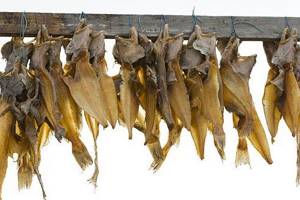
Feeling that she has hit the walls, begin to slowly move your fingers under the insides. Grab them and move them, slightly tearing them off, all the way to the head. Extremely neat - there's a gallbladder here. Don't forget to wash your belly well!
TIP: Have you damaged the integrity of your gallbladder? Don’t be upset, just immediately rub salt where the bile touches the fish. You can cut it out with a knife, but immediately and carefully, without damaging the integrity!
Step 5. Gut the fish
Then it all depends on what you are preparing. That is, use it completely or without the head and tail, say, you need a fillet or carcass.
In the second case, we place the fish on the board and, holding its head with the second hand, cut it off smoothly and quickly.
ATTENTION: During careful cleansing of the insides, it is better to go deep under the head with your index finger - blood clots are constantly hiding there, which will spoil the taste of the dish. Especially if you want to make fish soup from the trimmings! Wash later several times with water. Grab the fins on both sides with a knife - there will be a good piece of meat there.
Step 6.
Let's cut off the head with the fin
Unfold the carcass so that it is comfortable to carry out the remaining procedures. The tail needs to be removed. If you are not going to make a set for fish soup, you should simply cut off the tail, making an incision very far from it, so that there is a lot of meat.
Step 7. Cut off the tail
Do you want to make some soup since the fish is large? Then cut off all the parts so that there is more meat in them (in the area of the head, tail, and fins).
Don't forget to remove the gills from the head and eyes. This is such a wonderful cut!
Step 8. Headless carcass
Are you faced with the task of chopping steaks? If the fish is small, there will be no problems. But with the big one you will have to tinker, because the pieces should be beautiful and even. You can cut it with a sharp knife to the ridge, and then cut it with a cleaver.
Step 9. Steak
But do you need to separate the fillets? Which one - in pieces or the whole carcass?
Let's begin. The process is complex, but real. Using a sharp knife, run the knife along the entire length of the ridge. Have you reached the bones? Now carefully move the knife to the bottom, prying the meat. You will get two fillets. If you already have steaks, do the same, separating the meat at the backbone.
Step 10. Separate the fillet
Then do as the upcoming scenario asks. That is, it will be either two fillets, or you will cut them into slices. The main thing is to get rid of all the bones, do not throw away a single fin or spine!
I'd like to give it a try - this is an excellent set of fish soup I've come up with. Someday I’ll post the recipe for the soup that came out of it!
Step 11. Set for fish soup
Option No. 3
Everything is simpler here in terms of removing scales. Dipping the carcass in boiling water for a few seconds will simply get rid of it.
Using a sharp knife, make two cuts across the head and closer to the tail. Rip open the belly and gut the carcass.
Cut the upper fin with 2 longitudinal cuts side by side, and pull out the lower one.
Remove the gills and eyes from the head.
Cut steaks or fillets and cook!
The usual picture after cleaning fish is scales all over the kitchen and a nervous housewife. It’s even worse if she doesn’t even know how to approach the fish.
/p>
Let's figure out how to make this activity simple and quick.
How to remove offal
— It is better to gut the fish and remove its scales immediately (at least on the same day). - You need a cutting board.
To prevent the smell of fish from becoming ingrained in it and to speed up the next cleaning process, place a bag or newspaper on the board. — Holding the fish belly down, you need to make a cut on it from head to tail. - Use a spoon or knife to remove the contents. — There is a black film on the walls of the belly, which must be removed without fail. - Carefully wash the fish.
How to get rid of scales
— If the fish is slippery (after defrosting), you need to wash it.
In addition, if you sprinkle your hands with salt, the fish will not slip out. You can hold it with a towel. - A large vessel (basin, bowl) will be useful, into which the fish is placed completely. To ensure that the kitchen remains clean, you can clean the fish in a thick cellophane bag under running water. — We wet the fish with dried scales with water, wait a few minutes and clean it. - Before all this, you need to cut off the sharp fins and head (if it is not in the recipe). — The scales are removed using a special grater, knife, fork and even a teaspoon. — It is necessary to clean the scales from the tail to the head, that is, against its growth.
We begin cleaning with small, sharp movements. First you need to clean the sides, and then the belly. — After washing the fish, we get rid of the stuck scales and evaluate the quality of the work.
If the fish is going to be boiled or smoked, you don’t have to peel the scales. This will preserve more of the necessary substances. In addition, you can purchase already cleaned fish. I also recommend trying a fish scaler.
Cleaning by fish type
It is necessary to take into account that the method of how to quickly and correctly clean fish depends on its characteristics.

In particular, mackerel and flounder have no scales. In burbot and catfish it is extremely small, almost unnoticeable. The strongest scales are found in pike perch, crucian carp, carp and perch.
Perch
It is extremely difficult to clean the scales of a perch, so the scales are removed together with the skin.
Zander
The fin on the back of a pike perch is extremely hard. We cut the fish under and above the fin, after which it can be removed.
Horse mackerel
Before cleaning, you need to dip it in boiling water for 30 seconds, because the scales are extremely hard.
Catfish
After gutting, removing the head and fins, it is necessary to divide the fish into fillets, from which the skin is removed.
Burbot, eel
An incision must be made around the head and the skin removed like a stocking.
When gutting, the burbot liver is separated and cooked separately.
Tench
Tench's scales are compacted and small, covered with mucus, which makes cleaning extremely difficult. First you need to place the fish in boiling water, then in cool water. Now you can clean the mucus, scales and gut.
Hake
It is necessary to clean the small scales and remove the abdominal membrane. The skin of a large fish is rough, so remove it.
Som
It is necessary to clean the mucus, gut it and cut off the head with fins.
If the fish is extremely large, you can cut it before removing the skin.
Cod
The liver is used as food. There is a belly film that needs to be removed.
Lamprey
This fish is not gutted. After cleaning the mucus, you need to rub it with salt and rinse.
Flounder
Remove scales from the light side. The black skin of the tail must be cut and removed. It is better to first dip the flounder in boiling water.
Sole
Cut the head from the back and remove the entrails. Remove the skin like a stocking, cutting at the tail.
Tricks to speed up cleaning
Method 1: How to quickly clean fish: Place the fish in boiling water for two to three minutes.
After this, the scales are simply removed with your fingers under running water.
Method 2: how to quickly clean fish: Boil the gutted fish. After this, removing the scales and pulling out the bones is even easier.
Method 3 how to quickly clean fish: Pre-soak in cold water with a small amount of vinegar.
How to remove the skin from a pike with a stocking?
One of the easiest cleaning methods is to remove the skin using a stocking. But to do this you need to follow these fairly simple steps:
Cleaning the scales
From the very beginning you need to rid the fish of scales. This is probably one of the most difficult stages, because the scales of pike are quite hard and grow very densely. To avoid clogging the entire kitchen, it is better to clean it in the sink or outside. You need to peel against the growth; to do this, use a sharp knife with a comfortable block.
Preparing to remove the skin
After the carcass is cleaned, it needs to be washed and blotted a little with a paper towel to remove excess moisture. The next steps require a lot of space, so it’s worth clearing the entire surface of the table. Also, you need to take a cutting board, a sharp knife and a small container for waste.
The process of skinning pike
This stage is the most difficult and responsible. Using a sharp knife, make a few cuts along the gills, but the strip that connects the head and back of the fish should not be damaged. After this, you should pull out and throw away the insides. This must be done carefully so as not to damage the gallbladder and the surface of the skin.
Before you start removing the skin, you need to pry it a little with a knife at the base of the head. Sometimes the fins are cut off, but this is not worth doing, because then there will be unsightly holes that will have to be sewn up.
What do you need to clean fish?
Fish cleaning tools
- Sharp knife .
If this is your first time doing this, do it with the blunt side and either take a dull knife. After all, large scales can be removed even with a fork. If you have a scraper adapted for these purposes, or a grater, then in the case of small scales this will be great.
TIP: Make your own grater. Previously, bottle caps helped out - I nailed a few to a board and off I went. At this point, you can take an empty tin can, cut its ends, and nail it to a board with the bottom.
- Paper towel.
- Cutting board.
- Kitchen scissors.
- Water for rinsing hands.
Tips on how to cut pike in the field
Sometimes you want to cook caught fish right in the wild, without waiting for you to arrive home. Even though you don’t have a comfortable environment or many gadgets at hand to help you cut a pike, it can be done.
A few simple tips to help cut up your prey: First, you need to clean it of scales and entrails. This is easy to do with a knife, which fishermen always carry with them.
It must be washed very thoroughly so that there is no smell of mud left. It is better to rinse it several times, because marinating it will not remove the unpleasant odor.
What is better to clean fish with a spoon or karcher
To reduce the number of scales flying around the kitchen, you can clean the fish with a spoon. The cleaning process is the same as using a knife or grater, but the advantage is that most of the scales remain inside the concave part of the spoon.
We recommend reading:
Tour operator "Anex Tour"
At the same time, it is cleaned quite simply and relatively quickly. For greater convenience in this case, it is better to place the fish on the table and hold it with your hand. By the way, even if it is slippery and heavily covered with mucus, this will hardly interfere with its cleaning using this method, perhaps only slowing down the process a little.
Another unusual method invented by motorists is the use of a Karcher portable car wash. The fact is that water from the hose is supplied under high pressure. If you press the fish to a hard surface, for example, to the ground, and direct a jet at it, the scales themselves will fly out from under its pressure.

But rest assured that you will be guaranteed a fountain of scales mixed with splashes. It may not be possible to completely clean the fish in this way, but most of it can definitely be freed from the outer cover, and the remaining scales can be removed manually. What is better to use in this case? Hard to tell. Everyone chooses a method at their own discretion.
Some people want less dirt, while others want less fiddling with their hands. The final choice of cleaning tool will depend on this.
Author of the publication
offline 2 years
Nika
7
I am interested in hiking and traveling, photography and videography. I have been going hiking since childhood. The whole family went and went - sometimes to the sea, then to the river, to the lake, to the forest. There was a time when we spent a whole month in the forest. We lived in tents and cooked over fires. This is probably why I am still drawn to the forest and, in general, to nature. I travel regularly. About three trips a year for 10-15 days and many 2 and 3 day hikes.
Comments: 0Publications: 668Registration: 10/23/2018
Nika Survival in the wild, Nutrition in the wild, Articles
Pike recipes
There are a huge number of delicious recipes from this fish that will become a real table decoration. Very often housewives bake this fish whole, because it turns out very juicy and tasty.
Stuffed pike
The recipe is very simple. You will need the following ingredients:
- Pike - 2 pcs.
- Onion - 1 pc.
- Carrots - 1 pc.
- loaf
- Egg - 1 pc.
- Dill
- Salt
- Pepper
- Olive oil
Cooking steps:
- The carcass should be cleaned of scales and entrails. Remove the head, cut out the gills and wash the fish thoroughly. Using a knife, pry the skin off and remove it with a stocking, carefully trimming it to make the process easier. Cut off the tail and fins.
- To prepare the filling you need to use one fish fillet. You need to cut off several pieces from the loaf and soak it in boiled water. Grind the fillet, add the softened loaf pulp.
- The onion should be chopped very finely, the carrots should be grated on a fine grater. All this needs to be fried a little in olive oil. Salt and pepper.
- Mix all ingredients thoroughly in a large container, beat in the egg and add chopped dill.
- Knead all this and stuff the carcass of another fish. The filling should not be placed very tightly. The edges of the belly should be secured with toothpicks so that the filling does not fall out during cooking.
- The head can be baked along with the body, but before doing this it should be wrapped in foil so that it does not burn.
- Line a baking tray with paper and pour a little oil. Place the stuffed carcass on it and brush it with a little oil.
- Bake the fish in an oven preheated to 180 degrees for about 40-50 minutes.
- After it is completely cooked, you should not immediately transfer it to a plate; you need to let the pike cool a little so that the dish does not fall apart.
Pike cutlets
An incredibly tasty recipe for the most tender pike cutlets. For preparation you will need the following ingredients:
- Pike fillet – 500 g
- Lard - 100 g
- White bread crumb - 2-3 slices
- Milk – 100 g
- Onion - 1 pc.
- Egg - 1 pc.
- Breadcrumbs
- Greenery
- Salt
- Spices
- Sunflower or olive oil
Cooking steps:
- Fish fillets and lard should be minced. Lard will make the cutlets more juicy and soft; if you don’t have it, you can add a little olive oil to the minced meat.
- Carrots and onions can also be minced or very finely chopped.
- Soak the bread crumb in milk and leave for a few minutes to absorb it.
- Mix all ingredients in a large container. Beat in the egg, salt and add chopped cilantro and spices. Mix all this thoroughly and form small balls.
- Roll future cutlets in breadcrumbs and place on a heated frying pan.
- Fry for a few minutes on both sides until golden brown. To steam them better, you can cover the frying pan with a lid.
bolshoyulov.ru
Fish cutting
In stores you can easily find already cleaned and cut up flounder, which you can immediately cook without any tricks. However, in this case, you will not be able to fully control the freshness of the product, and the cost of the cut carcass will be higher.
I myself believed that cutting and cleaning this delicacy was a long and difficult task, so buying a ready-made product seemed more logical. In fact, there is nothing difficult in cutting fresh fish, so there is no point in depriving yourself of the pleasure of eating it.
Fresh fish
Here are step-by-step instructions for the cutting procedure.
- Before cutting, rinse the flounder thoroughly with tap water. Place it on a special cutting board with the dark side up. Using scissors, cut off the tail and fins, and remove the spines if there are any.
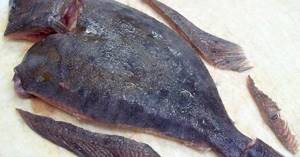
- Make a V-shaped cut on both sides of the head.
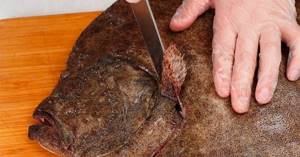
- Separate the head from the body. Carefully remove the internal organs from the resulting hole.
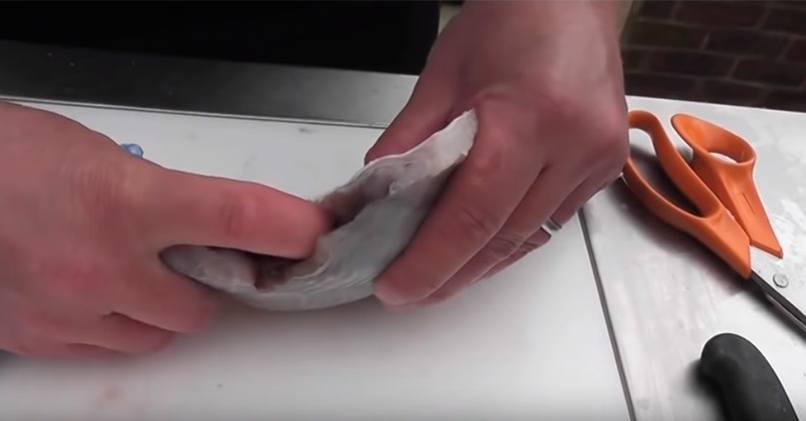
- Make a cut along the center of the back and separate the skin from the meat by prying it up with a knife.
Attention! During gutting, be careful not to puncture the gall bladder and thereby spoil the taste of the dish.
Next, you can cook the fish whole without deboning it, or remove the fillet with a knife and cut it into pieces.
Frozen fish
Cutting a frozen carcass is no different from working with a freshly caught one, except for one thing: before cutting the fish, it must be thawed. To do this, just transfer the flounder from the freezer to the refrigerator for 3-4 hours, and then let it lie for half an hour at room temperature and rinse thoroughly in running water.
I advise you to watch a visual video with step-by-step cutting.
How to clean pike from scales and entrails?
The dense and hard scales of pike are quite difficult to clean. To do this you will need a sharp knife and limited space. If you do this on the kitchen table, you should be prepared for pike scales to scatter throughout the room. It is better, of course, to clean the fish in the courtyard of a private house, but in extreme cases, a deep wash will do.
The scaled fish is washed and dried with paper towels. This must be done so that the fish does not slip in your hands. Now you need to remove the insides. To do this, immediately behind the gill bones, an incision is made on the left side of the scalp up to the ridge. You need to cut on the left, since the gall bladder is located on the right, which can burst when cutting fish. Next, a horizontal incision is made at the anus, and the intestines are trimmed.
Now the head needs to be finally cut off without touching the gall bladder, and separated from the carcass along with the intestines. Next, the fish is cut along the belly, finally cleaned of films and washed. Now the pike can be filleted.
How to properly cut a carcass
After cleaning the scales, the fish must be cut in order to proceed to the cooking stage.
- Pressing the carcass to the cutting board, we make an incision on the back at the base of the head. If we plan to cook fish without a head, we cut it off immediately.
- Then we make a cut along the ridge.
- We cut through the belly along the entire length of the carcass.
- We take out the insides.
- Rinse under running water.
- Inserting a knife into the cut on the back, smoothly cut the fillet from the bones.
- Turn over to the other side. Cutting meat from bones will now be easier from the tail.
- Place the halves on the board so that the skin is in contact with the work surface.
- Holding the knife at an angle of 45 degrees, pry the skin at the base of the tail.
- Cut the fillet from the skin.
- Let's probe it. If there are small bones left, remove them with tweezers.

Fish cutting
How to gut with Chinese chopsticks
This method of gutting fish is used when it is necessary to keep the carcass intact.
- On the abdomen near the caudal fin, make a shallow transverse cut with kitchen scissors or a knife.
- When you tear off the fish's mouth, insert a stick inside, moving it over the gills.
- Pressing the gills with a stick, we insert the stick deeper, pushing it inside until the cut on the abdomen.
- We do the same with the second stick, on the other side of the carcass.
- Holding the carcass tightly, we bring the ends of the sticks together from the outside and begin to twist them.
- As you scroll the sticks, we gradually pull them out of the carcass.
- We remove the insides along with the gills from it, rinse the inside with water.
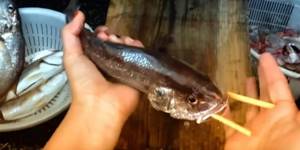
We pinch the ends of the sticks and twist them
How to gut fish the Chinese way
How to skin and fillet pike
To fillet pike you will need a special sharp fish knife. It is very convenient to use. It is enough to apply the knife tightly to the ridge and run it horizontally along. Similar steps must be repeated on the other side of the carcass. As a result, you will be able to get two fillet halves with skin. The ridge with leftover meat can be used to prepare fish stock.
How to quickly skin a pike? Again using a knife. You need to press it as tightly as possible to the skin and simply move it along. There may be some meat left on the skin, but it will be less than if you remove the skin by hand.
Video: Cleaning perch at home
And for those who do not want to read, watch and delve into the above options, we suggest watching this video. The author of the video showed by his own example how to quickly clean a perch at home.
Friends, you have learned five simple and effective ways to clean “striped robbers”. However, we are sure that there are many more of them in nature! So the question is: what method do you use? From those that we have listed? Or is there one of your own, developed over the years, and passed on from generation to generation?
How to skin a pike with a stocking: 2 ways
It is much more difficult to remove the skin from pike for stuffing. In this case, it is important not to tear or damage it. If you perform the steps correctly, you should end up with a stocking that will later be filled with minced meat.
Let's look at two ways to skin a pike with its head cut off. In the first case, all actions will be performed by one person, that is, independently. In the second case, you will need to use the help of another person.
First, you need to cut off the head so that the intestines can be pulled out immediately during its separation from the body. Then the skin on the carcass is carefully lifted with your hands at the incision site, and then, using your fingers, it is separated from the meat by at least 5 cm on each side. Now that part of the skin has already been separated, you need to start turning the skin outward, like a stocking. The fins are cut inside with scissors in such a way that the skin is not damaged, and the tail ridge can be cut off or broken. The head is also cooked along with the rest of the fish, so the gills are removed, washed and cleaned.
The second way to skin a pike is to get rid of the skin as quickly as possible. But doing this yourself is quite difficult, since the slippery pike is not easy to hold in your hands. In this case, when the skin is separated from the meat by at least 5 cm, one person will hold the fish vertically (you can use a towel), and the other will pull the skin down. In general, these two methods are equally effective.
How to cut fish in different ways
Fish products can be cut in different ways. It depends on how we are going to prepare them.
How to quickly fillet
To quickly and efficiently fillet the meat, we need a sharp knife.
- Place the fish on a cutting board.
- Cut off the head.
- We make an incision along the ridge along the back.
- Cut the carcass into halves, separating it from the bones.
- Place half of the carcass on the board so that the meat is on top.
- We pry the skin with the tip of the knife, holding it with our fingers.
- Cut the fillet, holding the knife at an angle.

When separating the fillet from the skin, hold the knife at an angle
This method is also called “Finnish”. For cutting, it is more convenient to use a knife with a long blade.
For portioned “round” pieces
- After cleaning the scales, remove the remaining fins.
- Cut off the head.
- The skin and spine are not removed.
- We clean out the insides through the hole formed after cutting off the head. You can use a tablespoon.
- We clean the inside of the carcass from films. We do not cut the belly, we leave it whole.
- We rinse from the inside.
- Dry lightly.
- Cut into portions - rings, or, as they are also called, “rounds”.
- The thickness of the pieces varies from 1 to 2 cm.
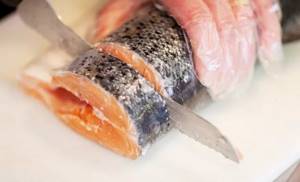
Cut into portions
For stuffing
Basically, fish is stuffed either in portions or whole.
- When cleaning scales, we try not to damage the skin.
- We make deep cuts on the back.
- We cut through the rib bones running along the ridge.
- We break the ridge at the tail and head and remove it from the carcass.
- We remove the insides through a cut on the back.
- We rinse from the inside.
- Cut out the meat and bones from the inside.
- Leave the meat on the skin 1/2 cm thick.
- Remove the gills and eyes from the head.
- Stuffing.
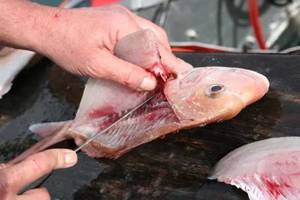
To remove the ridge, make an incision along the back
Another way to cut fish
- We cut the skin around the head of the fish.
- Pry it with the tip of a knife.
- We remove the skin with a “stocking” from the carcass.
- We cut the ridge at the tail.
- We wash the skin without separating it from the tail.
- We gut the carcass and wash it.
- Separate the bones.
- We use the meat as minced meat and stuff the removed skin.
- We tie it with thread and cook.
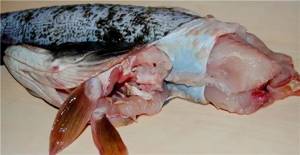
For stuffing, remove the skin from the carcass using a “stocking”
For minced meat
- We cut the fish in the same way as for fillet.
- We remove medium-sized bones using tweezers.
- Scroll the meat through a manual meat grinder 2-3 times.
- Simmer the minced meat for 1-2 minutes until the smallest bones that could get into the minced meat are completely softened.
- The minced meat is ready.
When using this method, a manual Soviet meat grinder is indicated. You can also use other household appliances: a food processor, blender or electric meat grinder. But a food processor or an electric analogue of a meat grinder does not grind fish bones so finely, there is a high risk of injury after eating the finished minced meat.
I often make cutlets from silver carp. I buy a whole silver carp, tear off the skin along with the scales, it pulls off like a stocking. I cut the meat from the backbone, I get two fillets without large bones. I grind it in a Soviet meat grinder, all the bones remain in the meat grinder, and then I make delicious cutlets from the minced meat.
AntiTroll
https://sovet.kidstaff.com.ua/question-678004
I made minced meat in a food processor, it turned out fluffy, but the machine doesn’t grind the bones, I tried it once.
Anna
https://sovet.kidstaff.com.ua/question-678004
How to skin a pike for stuffing with the head
The methods described above are more suitable for beginners, since professionals separate the skin directly from the head without cutting it off. Then, when stuffing, the fish will turn out whole. How to properly skin a pike in this case?
When preparing a fish, its head is not completely cut off, but remains hanging from the back on the skin. Next, the entrails are removed from the body, the head is cleaned and washed, as in the previous methods. How to skin a pike was also described above. By the way, after removing the stocking, it must be turned in the opposite direction again.
Preparing the stuffing filling
The taste of the finished dish largely depends on how well the filling was prepared. First of all, the meat separated from the bones must be twisted twice in a meat grinder. Moreover, after the first time, the device will need to be disassembled and the accumulated bones removed. When the meat is twisted for the second time, add fried onions and carrots, as well as a raw egg, salt and pepper to taste.
If the filling does not seem enough, you can add a couple of slices of bread soaked in milk to the minced meat. It needs to be rubbed well with your hands and mixed so that the mass turns out to be a homogeneous consistency.

